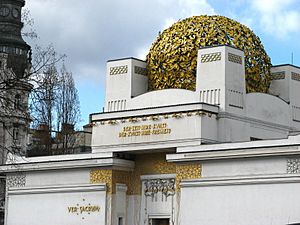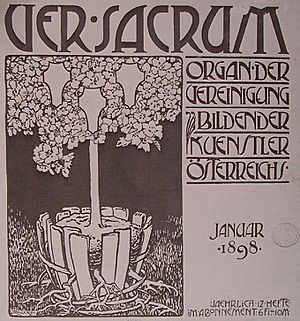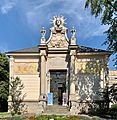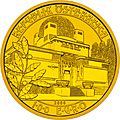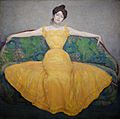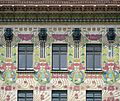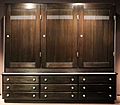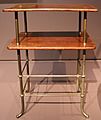Vienna Secession facts for kids
The Vienna Secession (also known as the Union of Austrian Artists, or Vereinigung Bildender Künstler Österreichs) was formed in 1897 by a group of Austrian artists who left the Association of Austrian Artists, housed in the Vienna Künstlerhaus due to its conservatism. This movement included painters, sculptors, and architects. The first president of the Secession was Gustav Klimt, and Rudolf von Alt was made honorary president.
It was founded on 3 April 1897 by artists Gustav Klimt, Koloman Moser, Josef Hoffmann, Joseph Maria Olbrich, Max Kurzweil, and others. Although the architect Otto Wagner is one of the most important members he was not a founding member. The first exhibition was held in 1898. In 1898, the group's exhibition house was built near Karlsplatz. It was designed by Joseph Maria Olbrich, the exhibition building soon became known simply as "the Secession" (die Sezession). Their work was also published in a magazin called "Ver sacrum".
1903 Josef Hoffmann and Koloman Moser founded the Wiener Werkstätten, a union of artists who wanted to reform the applied arts (arts and crafts). 1905 Klimt and other artists left the group due to different opinions about art.
- Other Secession artists
- Julius Exter
- Richard Gerstl
- Max Fabiani
- Oskar Kokoschka
- Jože Plečnik
- Carl Moll
- Koloman Moser
- Egon Schiele
- Malva Schalek
- Othmar Schimkowitz
- Joseph Maria Olbrich
Images for kids
-
Palace of Art, also known as "Secession", of the Kraków Society of Friends of Fine Arts, in Krakow Old Town
-
Dance by Koloman Moser (1902), inspired by dancer Lois Fuller
-
Illustration to The Goose Girl by Maximilian Liebenwein, published in Ver Sacrum in 1902
-
The Kiss by Gustav Klimt (1907–08)
-
Secession Building by Joseph Maria Olbrich (1897-8)
-
Floral design by Alois Ludwig on the facade of one of the Linke Wienzeile Buildings by Otto Wagner (1898)
-
A medallion by Koloman Moser and sculptures by Othmar Schimkowitz at Linke Wienzeile 38 (1898)
-
Church of St. Leopold by Otto Wagner (1902-1907)
-
Austrian Postal Savings Bank by Otto Wagner (1904-1912)
-
Stoclet Palace by Josef Hoffmann in Brussels (1905-1911)
-
Cabinet by Joseph Maria Olbrich, of maple, fruitwood, ebony and brass (c. 1900) (Los Angeles Country Museum of Art)
-
Armchair by Joseph Maria Olbrich made for the Darmstadt Artists' Colony (1900)
-
Cabinet made for the offices of the newspaper Die Zeit, Otto Wagner, (1902)
-
Bookcase by Koloman Moser (1902) (Los Angeles Country Museum of Art)
-
Inlaid Armoire by Koloman Moser (1903) (Leopold Museum)
-
Adjustable-back chair Model 670 "Sitzmaschine" by Josef Hoffmann (1905)
-
The monument to Mark Antony by Arthur Strasser (1899)
-
Beethoven torso statue by Max Klinger for XIV Secession exhibition (1902)
See also
 In Spanish: Secesión de Viena para niños
In Spanish: Secesión de Viena para niños


